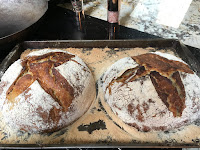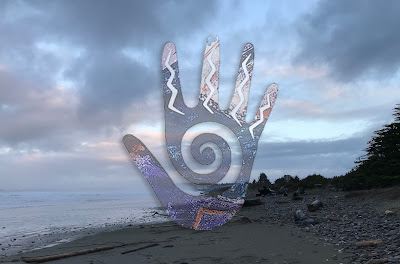I awaken this morning to the acknowledgement that today is St. Patrick's Day. The feast day in the Catholic religious tradition that honors Ireland's patron saint. Feast days are not actually days of feasting. Feast days are a religious and traditional practise in honor of a sacred moment or person (usually martyrs) that instills our connection to the Divine. The practise is much like Indigenous ceremonial observances. Indigenous traditional observances are seasonal and land based, they are acknowledgements of blessings and also hardships. Indigenous traditional ceremonies last over a weekend up to 10 days. Catholic Feast days last from one day to an average of a week. The traditional Christmas feast observance was 12 days. Our Christian observance of Easter was traditionally a week. Contemporary society has shortened our days of feasting from a week to a typical day. In traditional indigenous ceremonial practises, the duration of ceremonial days has stayed the same. However, fewer community members take part. Whereas, in the dominant society, the one day celebration has become secularized and most of the population takes part in their own manner.
We return to St. Patrick. The day that is observed is March 17 of any year, and is the commemoration of St. Patrick's death. Originally, he is honored for his miracles and what his efforts to bring Christianity to Ireland had done for the church. However, in the contemporary context, the general celebration is honoring the Irish peoples' heritage and culture.
To put it plainly, celebrations are about heritage and culture. They bring us together. They help us to heal.
So my question on writing this blog is What is Hinnak Towis Hennaak? Hinnak towis henaak is a manner of wellness addressed in my California matriarchal ancestral language,Tamal Machchawko (Coast Miwok). It literally translates to make/have a good life. For most indigenous peoples, making/having a good life is being well. A good life is wholeness and that wholeness for many of us is based and held together by culture, relatives, family/friends and our histories together that make up a heritage.
We heal when we can come together in a good way. We heal when we can establish good relationships with the land, ourselves in the world, our families and friends and what we do as we walk upon the Earth. When we are well and good, many miracles can take place in our lives and the everyday occurrences are immense blessings, much aligned with St. Patrick and his legacy in the Irish community.
From both a Christian and Indigenous perspective, miracles are the blessings that our connections to a spiritual consciousness and wellness establish in our lives.
We all have a heritage that connects us to our Mother Earth and to a specific region that can bestow to us knowledge and vitality, just as our relatives, the Irish and Indigenous people understand.
Hinnak towis henaak, is a complete, well-rounded consciousness that is embedded in our minds, heart and hands. How we think, how we feel, and what we do with ourselves stem from this consciousness.
Spring brings our sleepy, wintery awareness back to the land and to the world. Once the sun shines brightly, we can not ignore its presence and neither can our plant relatives. When we learn to acknowledge them, we can learn to have relationships with them.
After the long winter, I know I am ready to work on eating more fresh foods that the land offers in abundance locally, and I can take better care of my digestive system.
From the onset of our new year 2022, I've returned to some of my old practises. One is sourdough bread baking research, and kombucha brewing. Both practices incorporate fermentation production.
 |
| Sourdough loaves |
 |
| First of the year's Kombucha batch |
 |
| Pish Acorns |
As we age, our digestion requires more attention, especially if we have not incorporated the habit of eating fermented foods. I have many friends who, in the aging process, can not eat what they used to because of digestive concerns. I have always been sensitive to bread, pastas, and red sauces. Even more so as I have been aging. Hence, the fermented foods are a welcome into my palate. I am working to have my husband embrace them as well. I will not bore you will all the benefits of fermented foods. We are in the information age and a click away will do the trick.
Again, the process of fermentation takes time. If anyone has home brewed, you understand you will not get results immediately. The process is learning to have patience with a step by step routine.
When I make sourdough, I usually set up in my calender, every two weeks for the process. I make two loaves and they are good for a couple of weeks for my husband and myself. You can always freeze one loaf. Many times I give one loaf away. I usually take an evening to the next midday for the actual bread-making process. It's worth it. I do it all by hand, and I have to say that it's like working on the earth, and one of the most grounding and rewarding experiences as it benefits all round, emotionally (very calming), physically (I put in the effort and make a relationship with my kitchen and the bread itself), mentally (I know the goodness that will come from producing healthy foods) and spiritually (I'm taking time out to be within the process of creation).
I used to make Kombucha back in the 90s because it was a healthy food fad back then. I got the scoby mushroom from a friend, and made lots and lots of kombucha. It wasn't that tasteful, so my family did not help me drink it. Hence, I eventually gave it up, because I was doing fine, digestive wise then.
Present day, Kombucha is not a fad, but for many a drink they prefer because of the benefits and because of the taste. The taste has improved with the use of fruit juice and additional fermentation. Now, Kombucha is a refined connoisseur beverage. It is the beverage of my choice because I know what I put into my brews, and I also add additional fermentation with organic juice I add to the bottles that give a fiz. It is like drinking a health food soda pop without the chemicals and immense sugars. It takes me two weeks to make the foundation brew and an additional 3-4 days for the second fermentation to get the fizzy drink. Depending on your taste, you can brew for a month, or a week.
With all that being said, to live a good life, we must own it and we make our own decisions on how we wish to live. For the most part, it takes a bit more effort and time out of life for the really important things in life ... our health and our wellness.
So in the manner of Hinnak Towis Henaak, I am leaving you will a sourdough recipe that I have enjoyed. This recipe is from Gemma Stafford, Irish baker: Perfectly Crusty Sourdough Bread Recipe for Beginners.
For Kombucha information: You Brew Kombucha
Thank you for visiting and if you have any questions contact me.
PS: Also look into LUTEA's event page for any wellness events and programs. They are all free to attend.
We are presently preparing for our annual Mending Broken Hearts Healing Journey that supports those of us going through trauma, loss or grief. This is open to everyone who is willing to learn and participate in an Indigenous perspective of healing. Mending Broken Hearts.
